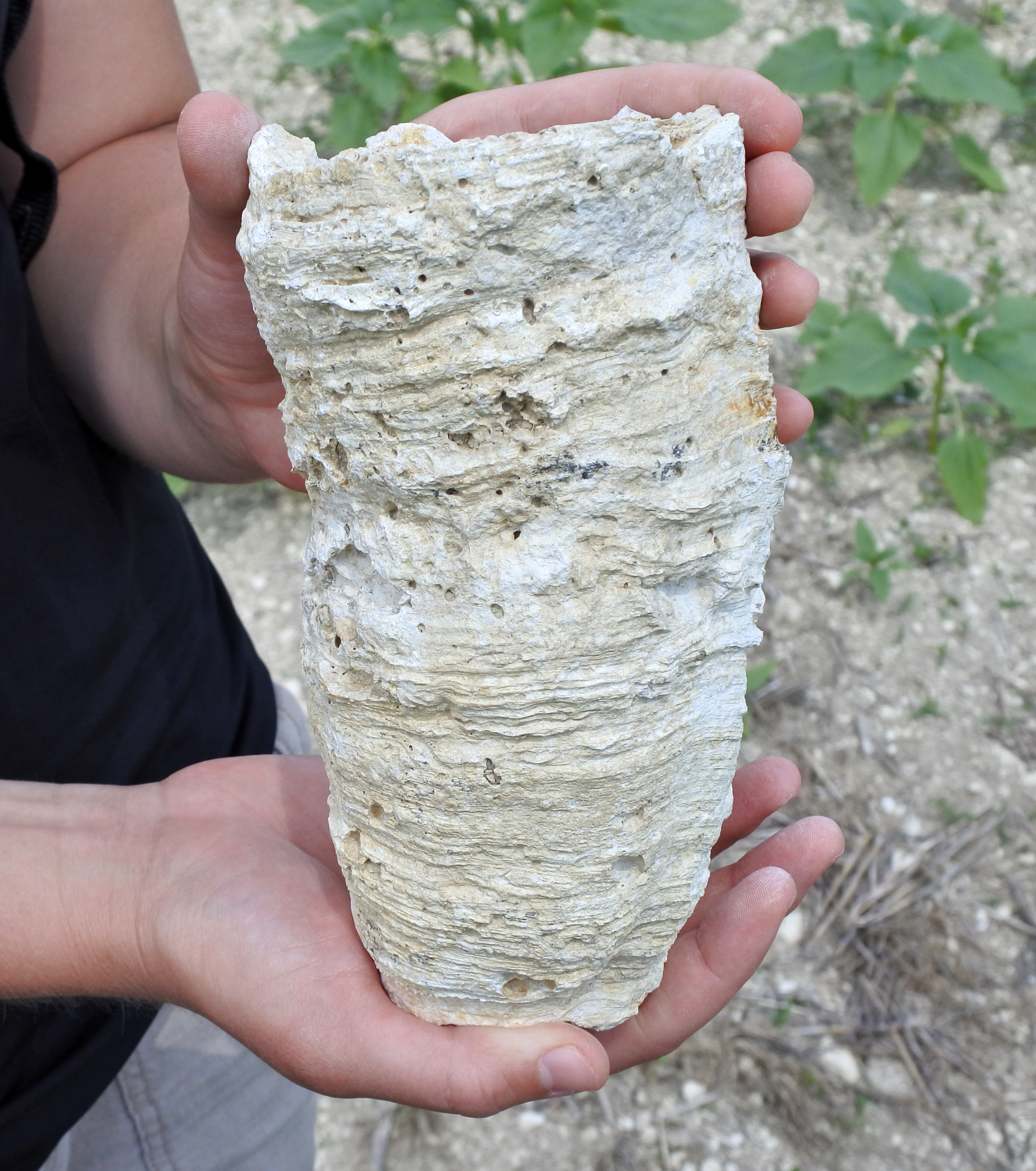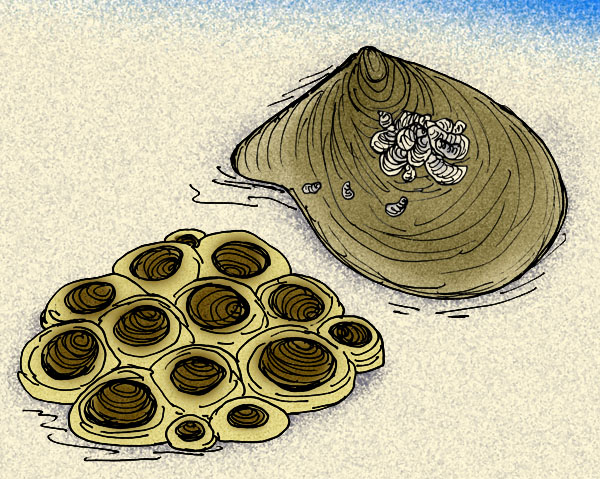|
Rudists
Rudists are a group of extinct box-, tube- or ring-shaped marine heterodont bivalves belonging to the order Hippuritida that arose during the Late Jurassic and became so diverse during the Cretaceous that they were major reef-building organisms in the Tethys Ocean, until their complete extinction at the close of the Cretaceous. Shell description The Late Jurassic forms were elongate, with both valves being similarly shaped, often pipe or stake-shaped, while the reef-building forms of the Cretaceous had one valve that became a flat lid, with the other valve becoming an inverted spike-like cone. The size of these conical forms ranged widely from just a few centimeters to well over a meter in length. Their "classic" morphology consisted of a lower, roughly conical valve that was attached to the seafloor or to neighboring rudists, and a smaller upper valve that served as a kind of lid for the organism. The small upper valve could take a variety of interesting forms, including: a ... [...More Info...] [...Related Items...] OR: [Wikipedia] [Google] [Baidu] |
Hippuritidae
Rudists are a group of extinct box-, tube- or ring-shaped marine heterodont bivalves belonging to the order Hippuritida that arose during the Late Jurassic and became so diverse during the Cretaceous that they were major reef-building organisms in the Tethys Ocean, until their complete extinction at the close of the Cretaceous. Shell description The Late Jurassic forms were elongate, with both valves being similarly shaped, often pipe or stake-shaped, while the reef-building forms of the Cretaceous had one valve that became a flat lid, with the other valve becoming an inverted spike-like cone. The size of these conical forms ranged widely from just a few centimeters to well over a meter in length. Their "classic" morphology consisted of a lower, roughly conical valve that was attached to the seafloor or to neighboring rudists, and a smaller upper valve that served as a kind of lid for the organism. The small upper valve could take a variety of interesting forms, including: a ... [...More Info...] [...Related Items...] OR: [Wikipedia] [Google] [Baidu] |
Jurassic
The Jurassic ( ) is a geologic period and stratigraphic system that spanned from the end of the Triassic Period million years ago (Mya) to the beginning of the Cretaceous Period, approximately Mya. The Jurassic constitutes the middle period of the Mesozoic Era and is named after the Jura Mountains, where limestone strata from the period were first identified. The start of the Jurassic was marked by the major Triassic–Jurassic extinction event, associated with the eruption of the Central Atlantic Magmatic Province. The beginning of the Toarcian Stage started around 183 million years ago and is marked by an extinction event associated with widespread oceanic anoxia, ocean acidification, and elevated temperatures likely caused by the eruption of the Karoo-Ferrar large igneous provinces. The end of the Jurassic, however, has no clear boundary with the Cretaceous and is the only boundary between geological periods to remain formally undefined. By the beginning of the Jurassi ... [...More Info...] [...Related Items...] OR: [Wikipedia] [Google] [Baidu] |
Maurens Rudist
Maurens is the name or part of the name of the following communes in France: * Maurens, Dordogne, in the Dordogne department * Maurens, Haute-Garonne, in the Haute-Garonne department * Maurens, Gers, in the Gers department * Maurens-Scopont, in the Tarn department {{geodis ... [...More Info...] [...Related Items...] OR: [Wikipedia] [Google] [Baidu] |
Chamoidea
Chamidae, common name the jewel boxes or jewel box clams, is a taxonomic family of saltwater clams, a group of marine bivalve mollusks in the order Venerida.Abbott, R.T. & Morris, P.A. ''A Field Guide to Shells: Atlantic and Gulf Coasts and the West Indies.'' New York: Houghton Mifflin, 1995. 53. Genera and species Genera and species in the family Chamidae: *''Arcinella'' Schumacher, 1817 **''Arcinella arcinella'' (Linnaeus, 1767) – spiny jewelbox **''Arcinella cornuta'' Conrad, 1866 – Florida spiny jewelbox *'' Chama'' Linnaeus, 1758 **'' Chama arcana'' Bernard, 1976 – secret jewelbox **''Chama congregata'' Conrad, 1833 – corrugate jewelbox **'' Chama echinata'' Broderip, 1835 **'' Chama florida'' Lamarck, 1819 – pretty jewelbox **'' Chama frondosa'' Broderip, 1835 **'' Chama hicksi'' Valentich-Scott & Coan, 2010 **'' Chama lactuca'' Dall, 1886 – milky jewelbox **'' Chama macerophylla'' Gmelin, 1791 – leafy jewelbox **'' Chama pellucida'' Broderip, 1835 **''Chama s ... [...More Info...] [...Related Items...] OR: [Wikipedia] [Google] [Baidu] |
Megalodontoidea
Megalodontoidea is a superfamily of fossil bivalves in the order Megalodontida. The following families are included in Megalodontoidea: *† Ceratomyopsidae *†Dicerocardiidae Dicerocardiidae is an extinct family of fossil saltwater clams, Marine (ocean), marine heterodont bivalve molluscs, in the order Megalodontida. Genera Genera within the family Dicerocardiidae: * †''Cornucardia'' Koken 1913 * †''Dicerocardium ... *† Megalodontidae *† Pachyrismatidae *† Wallowaconchidae References Bivalve superfamilies Bivalve taxonomy Prehistoric bivalves {{paleo-bivalve-stub ... [...More Info...] [...Related Items...] OR: [Wikipedia] [Google] [Baidu] |
Requieniidae
Requieniidae is a family of rudists, in the order Hippuritida, which lived from 155.7 to 66.043 million years ago. Taxonomy Placed by the WoRMS Worms may refer to: *Worm, an invertebrate animal with a tube-like body and no limbs Places *Worms, Germany Worms () is a city in Rhineland-Palatinate, Germany, situated on the Upper Rhine about south-southwest of Frankfurt am Main. It had ... and Fossilworks. Family Requieniidae Kutassy, 1934 * Subfamily: Matheroniinae ** Genus: '' Hypelasma'' ** Genus: '' Kugleria'' ** Genus: '' Lovetchenia'' ** Genus: '' Matheronia'' ** Genus: '' Rutonia'' * Subfamily: Requieniinae ** Genus: '' Apricardia'' ** Genus: '' Bayleia'' ** Genus: '' Bayleoidea'' ** Genus: '' Pseudotoucasia'' ** Genus: '' Requienia'' ** Genus: '' Toucasia'' References Prehistoric bivalve families Hippuritida {{Paleo-bivalve-stub ... [...More Info...] [...Related Items...] OR: [Wikipedia] [Google] [Baidu] |
Radiolitidae
''Radiolitidae'' is a family of rudists in the order Hippuritida. Fossil record These rudists lived between the Jurassic and the Cretaceous (age range: 130.0 to 66.043 million years ago). Genera Genera within this family include: * † '' Agriopleura'' Kühn 1832 * † '' Apulites'' Tavani 1958 * † '' Archaeoradiolites'' Fenerci-Masse et al. 2006 * † '' Biradiolites'' d'Orbigny 1850 * † '' Bournonia'' Fischer 1887 * † '' Bystrickya'' Lupu 1976 * † '' Chiapasella'' Müllerried 1931 * † '' Colveraia'' Klinghardt 1921 * † '' Contraspira'' Mitchell 2009 * † '' Darendeella'' Karacabey-Oztemür 1976 * † '' Distefanella'' Parona 1901 * † '' Dubertretia'' Cox 1965 * † '' Durania'' Douvillé 1908 * † '' Eoradiolites'' Douvillé 1909 * † '' Favus'' Laviano and Skelton 1992 * † '' Fossulites'' Astre 1957 * † '' Fundinia'' Sladić-Trifunović and Pejović 1977 * † '' Glabrobournonia'' Morris and Skelton 1995 * † '' Gorjanovicia'' Polšak 1967 * † '' Hacob ... [...More Info...] [...Related Items...] OR: [Wikipedia] [Google] [Baidu] |


